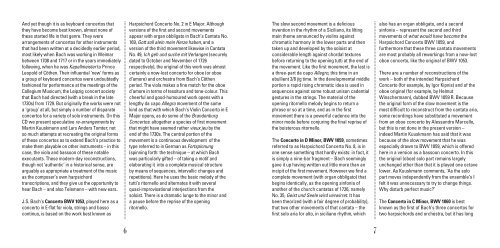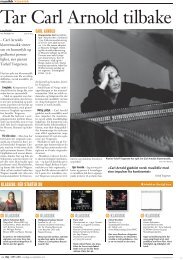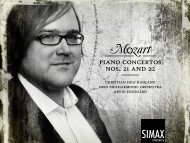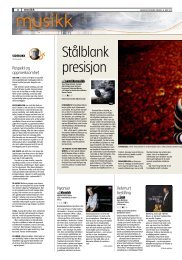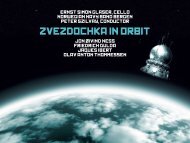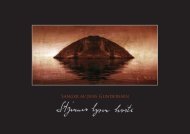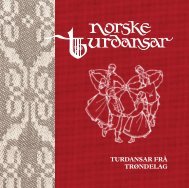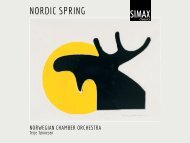J. S. BACH G. PH. TELEMANN 1B1 - Grappa Musikkforlag
J. S. BACH G. PH. TELEMANN 1B1 - Grappa Musikkforlag
J. S. BACH G. PH. TELEMANN 1B1 - Grappa Musikkforlag
Create successful ePaper yourself
Turn your PDF publications into a flip-book with our unique Google optimized e-Paper software.
And yet though it is as keyboard concertos that<br />
they have become best known, almost none of<br />
these started life in that genre. They were<br />
arrangements of concertos for other instruments<br />
that had been written at a decidedly earlier period,<br />
most likely when Bach was working in Weimar<br />
between 1708 and 1717 or in the years immediately<br />
following, when he was Kapellmeister to Prince<br />
Leopold of Cöthen. Their influential ‘new’ forms as<br />
a group of keyboard concertos were undoubtedly<br />
fashioned for performance at the meetings of the<br />
Collegium Musicum, the Leipzig concert society<br />
that Bach had directed (with a break in the late<br />
1730s) from 1729. But originally the works were not<br />
a ‘group’ at all, but simply a number of disparate<br />
concertos for a variety of solo instruments. On this<br />
CD we present speculative re-arrangements by<br />
Martin Kuuskmann and Lars Anders Tomter; not<br />
so much attempts at recreating the original forms<br />
of these concertos as to extend Bach’s practice to<br />
make them playable on other instruments – in this<br />
case, the viola and bassoon of these notable<br />
executants. These modern-day reconstructions,<br />
though not ‘authentic’ in a historical sense, are<br />
arguably as appropriate a treatment of the music<br />
as the composer’s own harpsichord<br />
transcriptions, and they give us the opportunity to<br />
hear Bach – and also Telemann – with new ears..<br />
J.S. Bach’s Concerto BWV 1053, played here as a<br />
concerto in E-flat for viola, strings and basso<br />
continuo, is based on the work best known as<br />
6<br />
Harpsichord Concerto No. 2 in E Major. Although<br />
versions of the first and second movements<br />
appear with organ obbligato in Bach’s Cantata No.<br />
169, Gott soll alein mein Herze haben, and a<br />
version of the third movement likewise in Cantata<br />
No. 49, Ich geh und suche mit Verlangen (securely<br />
dated to October and November of 1726<br />
respectively), the original of this work was almost<br />
certainly a now-lost concerto for oboe (or oboe<br />
d’amore) and orchestra from Bach’s Cöthen<br />
period. The viola makes a fine match for the oboe<br />
d’amore in terms of tessitura and tone-colour. This<br />
cheerful and good-humoured work opens with a<br />
lengthy da capo Allegro movement of the same<br />
kind as that with which Bach’s Violin Concerto in E<br />
Major opens, as do some of the Brandenburg<br />
Concertos: altogether a species of first movement<br />
that might have seemed rather vieux jeu by the<br />
end of the 1730s. The central portion of the<br />
movement is a continuous development of the<br />
type referred to in German as Fortspinnung<br />
(spinning forth: the technique – at which Bach<br />
was particularly gifted – of taking a motif and<br />
elaborating it into a complete musical structure<br />
by means of sequences, intervallic changes and<br />
repetitions). Here he uses the basic melody of the<br />
tutti’s ritornello and alternates it with several<br />
quasi-improvisational interjections from the<br />
soloist. There is a dramatic lunge to the minor and<br />
a pause before the reprise of the opening<br />
ritornello.<br />
The slow second movement is a delicious<br />
invention in the rhythm of a Siciliano, its lilting<br />
main theme announced by violins against<br />
chromatic harmony in the lower parts and then<br />
taken up and developed by the soloist at<br />
considerable length against chordal textures<br />
before returning to the opening tutti at the end of<br />
the movement. Like the first movement, the last is<br />
a three-part da capo Allegro, this time in an<br />
ebullient 3/8 jig time. In the developmental middle<br />
portion a rapid rising chromatic idea is used in<br />
sequences against some robust unison cadential<br />
gestures in the strings. The material of the<br />
opening ritornello melody begins to return a<br />
phrase or so at a time, and as in the first<br />
movement there is a powerful cadence into the<br />
minor mode before conjuring the final reprise of<br />
the boisterous ritornello.<br />
The Concerto in D Minor, BWV 1059, sometimes<br />
referred to as Harpsichord Concerto No. 8, is in<br />
one sense something that hardly exists: in fact, it<br />
is simply a nine-bar fragment – Bach seemingly<br />
gave it up having written out little more than an<br />
incipit of the first movement. However we find a<br />
complete movement (with organ obbligato) that<br />
begins identically, as the opening sinfonia of<br />
another of the church cantatas of 1726, namely<br />
No. 35, Geist und Seele wird verwirret. It has<br />
been theorized (with a fair degree of probability),<br />
that two other movements of that cantata – the<br />
first solo aria for alto, in siciliano rhythm, which<br />
7<br />
also has an organ obbligato, and a second<br />
sinfonia – represent the second and third<br />
movements of what would have become the<br />
Harpsichord Concerto BWV 1059, and<br />
furthermore that these three cantata movements<br />
are most probably all reworkings from a now-lost<br />
oboe concerto, like the original of BWV 1053.<br />
There are a number of reconstructions of the<br />
work – both of the intended Harpsichord<br />
Concerto (for example, by Igor Kipnis) and of the<br />
oboe original (for example, by Helmut<br />
Winschermann), dubbed BWV 1059 R. Because<br />
the original form of the slow movement is the<br />
most difficult to reconstruct from the cantata aria,<br />
some recordings have substituted a movement<br />
from an oboe concerto by Alessandro Marcello,<br />
but this is not done in the present version –<br />
indeed Martin Kuuskmann has said that it was<br />
because of the slow movement that he was<br />
especially drawn to BWV 1059, which is offered<br />
here in a version as a bassoon concerto. In this<br />
the original (oboe) solo part remains largely<br />
unchanged other than that it is played one octave<br />
lower. As Kuuskmann comments, ‘As the solo<br />
part moves independently from the ensemble’s I<br />
felt it was unnecessary to try to change things.<br />
Why disturb perfect music?’<br />
The Concerto in C Minor, BWV 1060 is best<br />
known as the first of Bach’s three concertos for<br />
two harpsichords and orchestra, but it has long


